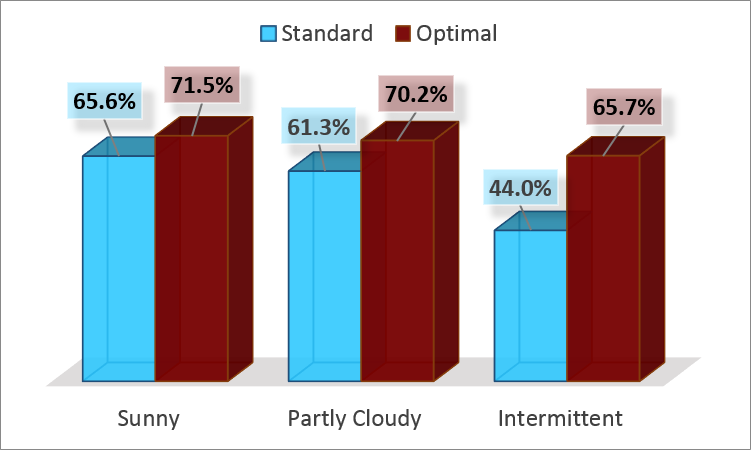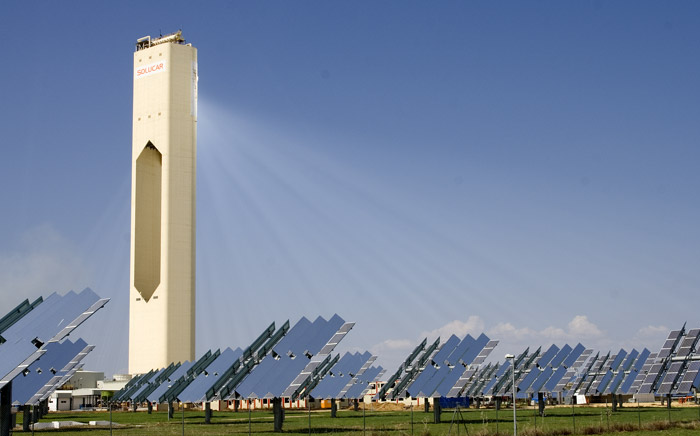Solar thermal power, which uses solar energy in the form of heat, has many advantages. One is that it uses conventional power generation equipment (like heat exchangers and steam turbines) to produce electricity. A second is that, unlike photovoltaics, energy from a solar thermal plant can be stored as heat, making for inexpensive energy storage. These factors make solar thermal power an ideal candidate for hybridization. Solar thermal power can be combined with conventional energy resources, such as natural gas, to provide clean, yet reliable energy.
Thermal energy storage (energy stored as heat) is critical with a solar thermal system, giving the system the ability to produce power on demand, despite fluctuating solar energy availability.

Thermal energy storage also gives the system enhanced flexibility, which can be exploited by dynamic optimization. When the system is operated in hybrid mode, only a portion of the power delivered comes from solar energy, with the balance coming from another source, natural gas in this case. This flexibility, combined with the use of energy storage, allow the system to collect solar energy more efficiently.

Comparing the outcomes highlights the value of thermal energy storage and optimization. Much more solar energy can be harvested when the system is flexible in operating between solar and fossil fuel inputs, as shown by the solar collection efficiency results below (red shows optimal hybrid operation results.

To learn more, check out these research papers.
Dynamic optimization of a hybrid solar thermal and fossil fuel system
Modeling and control of a solar thermal power plant with thermal energy storage
Current and Future Work
Applying a similar methodology, I’m currently working on developing novel thermal energy storage concepts for power tower systems, which can operate at temperatures high enough to run a gas turbine on a Brayton Cycle. This concept will allow the system to slide between solar and gas mode, while harvesting solar energy as sensible heat in a solid storage medium, such as concrete. Waste heat from the solar gas turbine can be used to generate additional power with a steam turbine in combined cycle. Combined cycle power is currently the most cost effective way to produce power (new construction), so combining this technology with solar thermal power will help drive down the cost of solar power.

 Thermal energy storage also gives the system enhanced flexibility, which can be exploited by dynamic optimization. When the system is operated in hybrid mode, only a portion of the power delivered comes from solar energy, with the balance coming from another source, natural gas in this case. This flexibility, combined with the use of energy storage, allow the system to collect solar energy more efficiently.
Thermal energy storage also gives the system enhanced flexibility, which can be exploited by dynamic optimization. When the system is operated in hybrid mode, only a portion of the power delivered comes from solar energy, with the balance coming from another source, natural gas in this case. This flexibility, combined with the use of energy storage, allow the system to collect solar energy more efficiently.
 Comparing the outcomes highlights the value of thermal energy storage and optimization. Much more solar energy can be harvested when the system is flexible in operating between solar and fossil fuel inputs, as shown by the solar collection efficiency results below (red shows optimal hybrid operation results.
Comparing the outcomes highlights the value of thermal energy storage and optimization. Much more solar energy can be harvested when the system is flexible in operating between solar and fossil fuel inputs, as shown by the solar collection efficiency results below (red shows optimal hybrid operation results.
 To learn more, check out these research papers.
Dynamic optimization of a hybrid solar thermal and fossil fuel system
Modeling and control of a solar thermal power plant with thermal energy storage
To learn more, check out these research papers.
Dynamic optimization of a hybrid solar thermal and fossil fuel system
Modeling and control of a solar thermal power plant with thermal energy storage


